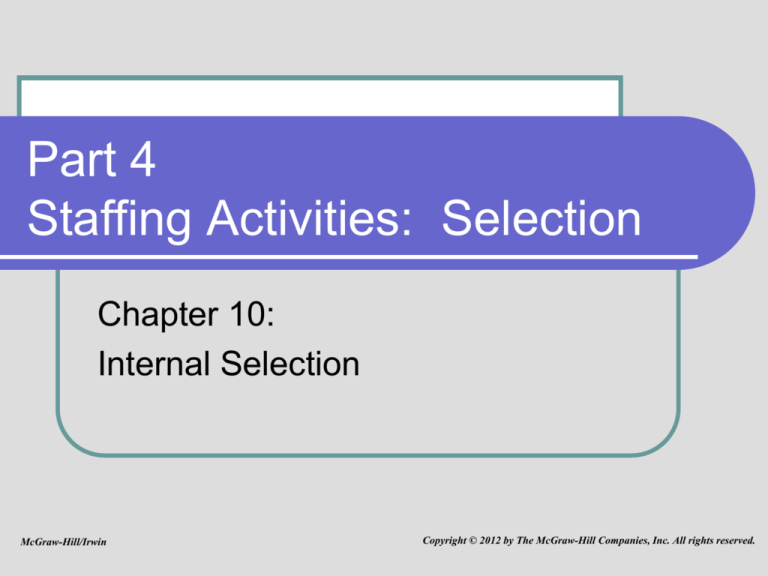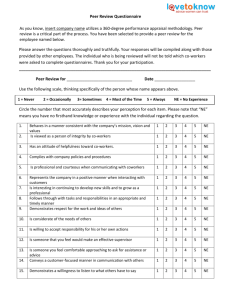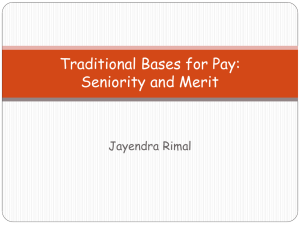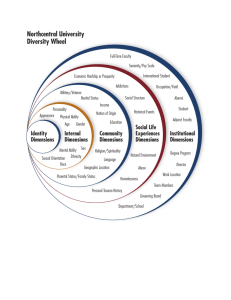
Part 4
Staffing Activities: Selection
Chapter 10:
Internal Selection
McGraw-Hill/Irwin
Copyright © 2012 by The McGraw-Hill Companies, Inc. All rights reserved.
Staffing Organizations Model
Organization
Mission
Goals and Objectives
Organization Strategy
HR and Staffing Strategy
Staffing Policies and Programs
Support Activities
Core Staffing Activities
Legal compliance
Planning
Recruitment:
Selection:
External, internal
Measurement, external, internal
Job analysis
Employment:
Decision making, final match
Staffing System and Retention Management
10-2
Chapter Outline
Preliminary Issues
Logic of Prediction
Types of Predictors
Selection Plan
Initial Assessment Methods
Skills Inventory
Peer Assessments
Self-Assessments
Managerial Sponsorship
Informal Discussions and
Recommendations
Choice of Methods
Substantive Assessment
Methods
Seniority and Experience
Job Knowledge Tests
Performance Appraisal
Promotability Ratings
Assessment Centers
Interview Simulations
Promotion Panels and
Review Boards
Choice of Methods
Discretionary Assessment
Methods
Legal Issues
10-3
Learning Objectives for This Chapter
Compare how the logic of prediction applies to
internal vs. external selection decisions
Evaluate the relative advantages and
disadvantages of the five initial assessment
methods used in internal selection
Consider the merits and pitfalls of using seniority
and experience for internal selection decisions
Describe the main features of assessment centers
Understand the advantages and disadvantages of
using assessment centers for internal selection
decisions
Evaluate the relative advantages and
disadvantages of the seven substantive
assessment methods used in internal selection
10-4
Discussion Questions for This Chapter
What are the differences among peer ratings,
peer nominations, and peer rankings?
Explain the theory behind assessment centers.
Describe the three different types of interview
simulations.
Evaluate the effectiveness of seniority,
assessment centers, and job knowledge as
substantive internal selection procedures.
What steps should be taken by an
organization that is committed to shattering the
glass ceiling?
10-5
Preliminary Issues
Logic of prediction
Types of predictors
indicators of internal applicants’ degree of success
in past situations should be predictive of their likely
success in new situations
there is usually greater depth and relevance to the
data available on internal candidates relative to
external selection
Selection plan
important for internal selection to avoid the
problems of favoritism and gut instinct that can be
especially prevalent in internal selection
10-6
Logic of Prediction: Past Performance
Predicts Future Performance
Advantages of internal over external selection
Greater depth and relevance of data available
on internal candidates
Greater emphasis can be placed on samples
and criteria rather than signs
10-7
Discussion Questions
Explain how internal selection decisions
differ from external selection decisions.
10-8
Initial Assessment Methods
Skills inventory
Peer assessments
Self-assessments
Managerial sponsorship
Informal discussions and
recommendations
10-9
Skills Inventory
Traditional
List of KSAOs held by each employee
Records a small number of skills listed in generic
categories, such as education, experience, and
supervisory training received
Customized
Specific skill sets are recorded for specific jobs
SMEs identify skills critical to job success
10-10
Peer Assessments
Methods include peer ratings, peer
nominations, peer rankings
Strengths
Rely on raters who presumably are knowledgeable
of applicants’ KSAOs
Peers more likely to view decisions as fair due to
their input
Weaknesses
May encourage friendship bias
Criteria involved in assessments are not always
clear
10-11
Ex. 10.1: Peer Assessment Methods
10-12
Initial Assessment Methods
Self-assessments
Managerial sponsorship
Job incumbents asked to evaluate own skills to
determine promotability
Exh. 10.2: Self-Assessment Form
Higher-ups given considerable influence in
promotion decisions
Exh. 10.3: Employee Advocates
Informal discussions and recommendations
May be suspect in terms of relevance to actual job
performance
10-13
Exhibit 10.4 Choice of Initial
Assessment Methods
10-14
Discussion Questions
What are the differences among peer
ratings, peer nominations, and peer
rankings?
10-15
Substantive Assessment Methods
Seniority and experience
Job knowledge tests
Performance appraisal
Promotability ratings
Assessment centers
Interview simulations
Promotion panels and review boards
10-16
Overview of Seniority and Experience
Definitions
Seniority
Experience
Length of service with organization, department, or job
Not only length of service but also kinds of activities an employee
has undertaken
Why so widely used?
Direct experience in a job content area reflects an
accumulated stock of KSAOs necessary to perform job
Information is easily and cheaply obtained
Protects employee from capricious treatment and favoritism
Promoting senior or experienced employees is socially
acceptable -- viewed as rewarding loyalty
10-17
Evaluation of Seniority and Experience
Employees typically expect promotions will go to most
senior or experienced employee
Relationship to job performance
Experience is superior because it is:
Seniority is unrelated to job performance
Experience is moderately related to job performance,
especially in the short run
a more valid method than seniority
more likely to be content valid when past or present jobs are
similar to the future job
Experience is unlikely to remedy initial performance
difficulties of low-ability employees
is better suited to predict short-term rather than long-term
potential
10-18
Job Knowledge Tests
Job knowledge includes elements of
both ability and seniority
Measured by a paper-and-pencil test or
a computer
Holds great promise as a predictor of job
performance
Reflects an assessment of what was
learned with experience
Also captures cognitive ability
10-19
Performance Appraisal
A possible predictor of future job performance
is past job performance collected by a
performance appraisal process
Advantages
Readily available
Probably capture both ability and motivation
Weaknesses
Potential lack of a direct correspondence between
requirements of current job and requirements of
position applied for
“Peter Principle”
10-20
Performance Appraisal
Ex. 10.5: Questions to Ask in Using
Performance Appraisal as a Method of Internal
Staffing Decisions
Is the performance appraisal process reliable and
unbiased?
Is present job content representative of future job
content?
Have the KSAOs required for performance in the
future job(s) been acquired and demonstrated in
the previous job(s)?
Is the organizational or job environment stable such
that what led to past job success will lead to future
job success?
10-21
Promotability Ratings
Assessing promotability involves determining
an applicant’s potential for higher-level jobs
Promotability ratings often conducted along with
performance appraisals
Useful for both selection and recruitment
Caveat
When receiving separate evaluations for purposes
of appraisal, promotability, and pay, an employee
may receive mixed messages
10-22
Overview of Assessment Centers
Elaborate method of employee selection
Involves using a collection of predictors to
forecast success, primarily in higher-level jobs
Objective
Predict an individual’s behavior and
effectiveness in critical roles, usually managerial
Incorporates multiple methods of assessing
multiple KSAOs using multiple assessors
10-23
Ex. 10.7 Assessment Center Rating Form
Participants take part
in several exercises
over multiple days
In-basket exercise
Leaderless group
discussion
Case analysis
Trained assessors
evaluate
participants’
performance
10-24
Characteristics of Assessment Centers
Participants are usually managers being
assessed for higher-level managerial
jobs
Participants are evaluated by assessors
at conclusion of program
10-25
Evaluation of Assessment Centers
Validity
Average validity ŕ = .37
Validity is higher when
Multiple predictors are used
Assessors are psychologists rather than managers
Peer evaluations are used
Possess incremental validity in predicting
performance and promotability beyond personality
traits and cognitive ability tests
Research results
“Crown prince/princess” syndrome
Participant reactions
10-26
Other Substantive Assessment Methods
Interview simulations
Role-play: candidate must play work related role
with interviewer
Fact finding: candidate needs to solicit information
to evaluate an incomplete case
Oral presentations: candidate must prepare and
make an oral presentation on assigned topic
Promotion panels and review boards: use
multiple raters, which can improve reliability
and can broaden commitment to decisions
reached
10-27
Exhibit 10.8 Choice of Substantive
Assessment Methods
10-28
Discussion Questions
Explain the theory behind assessment
centers.
Describe the three different types of
interview simulations.
Evaluate the effectiveness of seniority,
assessment centers, and job knowledge
as substantive internal selection
procedures.
10-29
Discretionary Assessment Methods
Narrows list of finalists to those who will
receive job offers
Decisions often made on basis of
Organizational citizenship behavior and
Staffing philosophy regarding EE0 / AA
Differences from external selection
Previous finalists not receiving job offers do
not simply disappear
Multiple assessors generally used
10-30
Legal Issues
Uniform Guidelines on Employee
Selection Procedures (UGESP)
Shattering the glass ceiling
Employ greater use of selection plans
Minimize use of casual, subjective methods and
use formal, standardized, job-related assessment
methods
Implement programs to convey KSAOs necessary
for advancement to aspiring employees
10-31
Discussion Questions
What steps should be taken by an
organization that is committed to
shattering the glass ceiling?
10-32
Ethical Issues
Issue 1
Given that seniority is not a particularly valid predictor of job
performance, do you think it’s unethical for a company to use
it as a basis for promotion? Why or why not?
Issue 2
Vincent and Peter are both sales associates, and are up for
promotion to sales manager. In the last five years, on a
1=poor to 5=excellent scale, Vincent’s average performance
rating was 4.7 and Peter’s was 4.2. In an assessment center
that was meant to simulate the job of sales manager, on a
1=very poor to 10=outstanding scale, Vincent’s average score
was 8.2 and Peter’s was 9.2. Assuming everything else is
equal, who should be promoted? Why?
10-33






